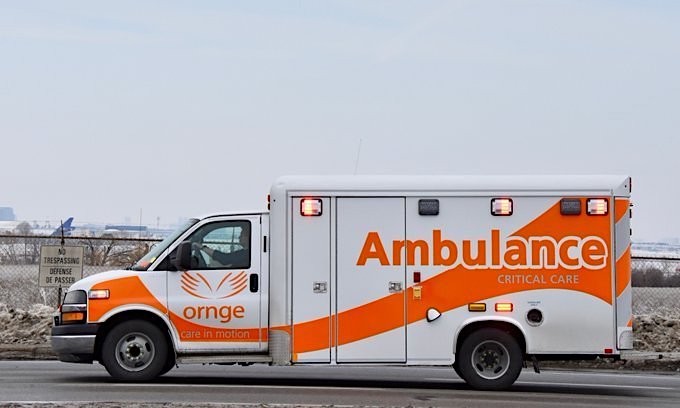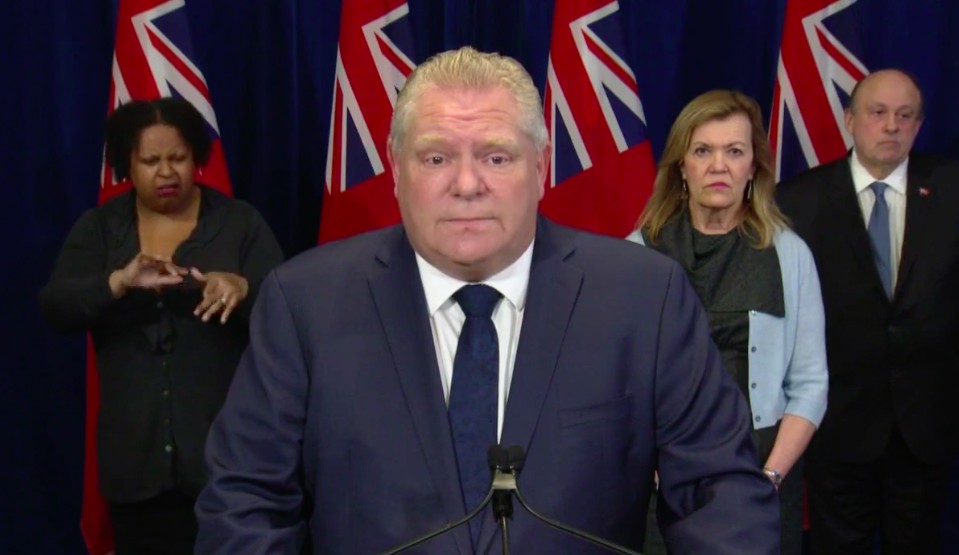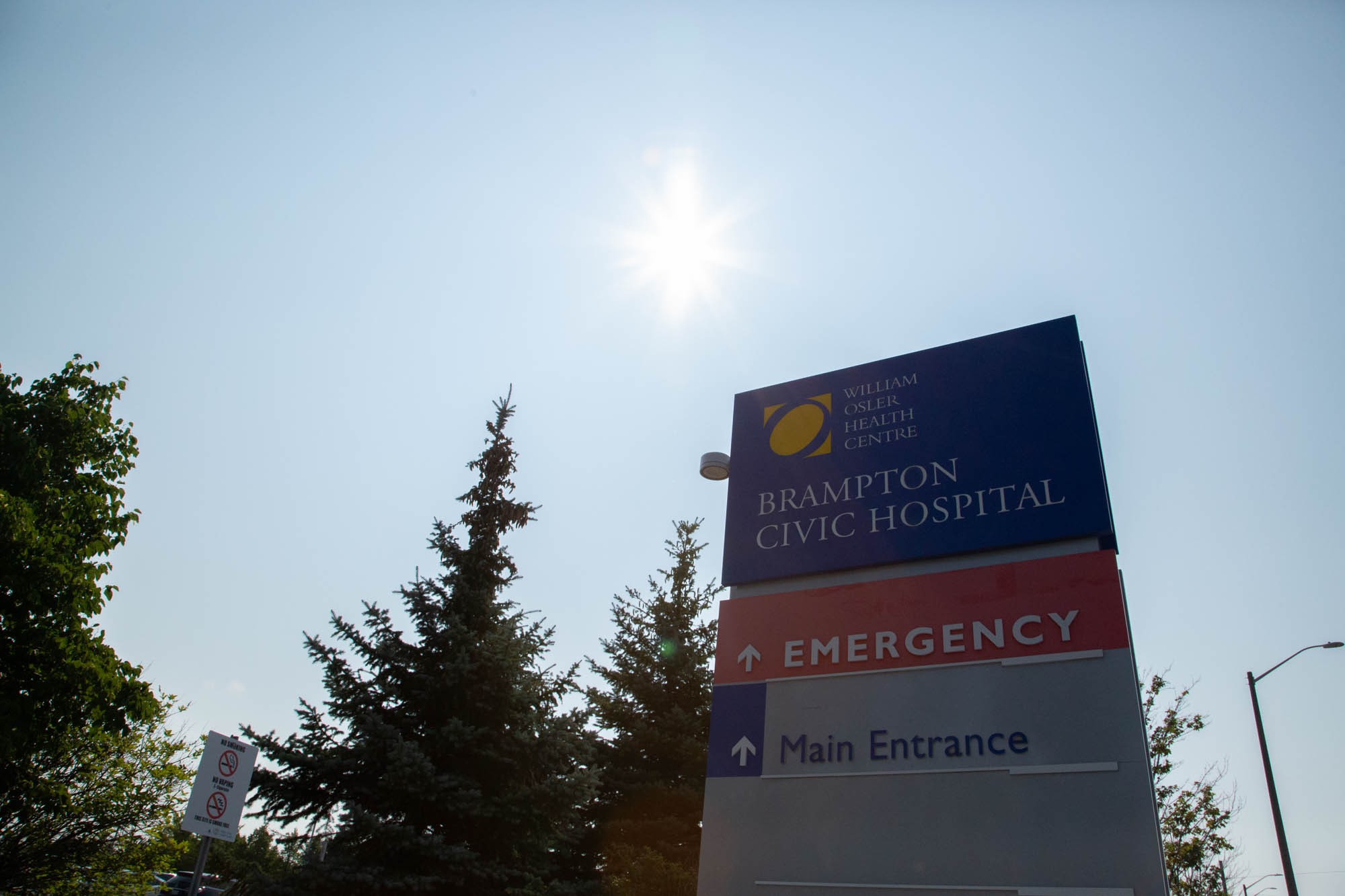
Province will find hospitals for patients if Mississauga or Brampton become overwhelmed by COVID-19
Teamwork.
That’s the message Premier Doug Ford evokes every time he finds himself in front of a microphone. Whatever questions are thrown at him, regardless of the day’s announcement, the same theme shines through. Team Ontario, once associated with provincial sports, is now a rallying cry to band together during uncertain times, accompanied by the newly coined “Ontario Spirit.”

Premier Doug Ford and the provincial government are taking a holistic approach to COVID-19, coordinating between hospitals that are struggling and those that might have space for more patients.
And it is together, as Team Ontario, the province hopes to handle hospital capacity issues in the face of COVID-19.
While Ontario’s healthcare systems are universally strained, the number of COVID-19 cases is different across cities and regions, meaning not all hospitals are reeling from the pandemic. In response, the province is taking a holistic approach, coordinating between hospitals that are struggling and those that might have space for more patients.
“We treat it as a provincial resource and we run it out of a central table,” Matt Anderson, president and CEO of Ontario Health, said during a tele-conference Friday. “This disease is not spreading equally and equitably across the province, we have hotspots or places where it goes up and we have other places where it has not been too pervasive yet.”
So far, COVID-19 numbers show Peel to be one of the province’s hotspots. On Thursday morning, the total number of positive cases in the region spiked to 362, with 137 in Brampton and 200 in Mississauga, a rise of 22 and 15 percent respectively. A heatmap created by the Ontario Medical Association, that lags roughly a day behind local reporting, illustrates Toronto, York Region and Peel as some of the hardest hit parts of Ontario.
A heatmap created by the Ontario Medical Association, that lags roughly a day behind local reporting, depicts Toronto, York Region and Peel as some of the hardest hit parts of Ontario.
In Peel, high case numbers are aggravated by hospital systems that have struggled with soaring populations and underinvestment for years. As The Pointer has extensively reported, Brampton Civic, the city’s only hospital capable of treating COVID-19 patients, operated above 100 percent capacity throughout 2019. In Mississauga, the city’s hospitals, run by Trillium Health Partners (THP), have some of the worst wait times in the province for admittance from the emergency room. A planning document written by THP in 2019 noted the current setup is “under-resourced for the size and needs of the community.”
This is far from the perfect starting point to battle COVID-19.
On March 20, William Osler told The Pointer it had 24 ICU beds and 10 Intermediate Care Units at Brampton Civic Hospital with a plan to expand further. William Osler’s website states there are currently 19 COVID-19 patients under its care (at either Brampton Civic or Etobicoke General), with no details on how many are in ICU beds. In Mississauga, THP had 100 critical care beds on March 18, with plans in place to double that number if necessary. On March 30, as part of that plan, the health network closed the emergency room at its Queensway Hospital. Data from THP’s website states it is currently caring for 31 patients with COVID-19.
While the number of patients under hospital care in Peel is fairly low, the cumulative nature of the pandemic means this may not be the case for long. On Thursday, the Ontario Ministry of Health reported that there are 167 COVID-19 patients in ICU across the province, of which 112 currently require the use of a ventilator. This represents an increase of 288 percent from the 43 ICU patients reported last Friday, averaging just under 50 percent per day.
In total, the province has 2,053 adult critical care beds, 1,321 of which are equipped with mechanical ventilators. At the beginning of March, Level 3 (the most specialized) critical care beds were at 95 percent capacity, now dropping to 85 percent.
On March 25, ICU occupancy in Ontario was at 68 percent with 400 critical care beds available. Since then, the additional 124 COVID-19 patients in intensive care have changed the landscape, although the province is yet to offer details.

William Osler Health System has 24 ICU beds and 10 Intermediate Care Units at Brampton Civic Hospital with a plan to expand further.
To help increase capacity within local hospitals, a number of instructions have been issued by the province and carried out by Osler and THP.
On March 21, Ontario issued new rules, in accordance with the Emergency Management and Civil Protection Act, extending the province’s state of emergency to increase space in hospitals by cancelling or postponing services. Among the measures, hospitals and doctors were told to ramp down elective surgeries to increase the number of staff available to fight COVID-19. Initial numbers suggest this had the desired effect, with hospital occupancy at 76.6 percent on March 25 compared to 96.9 percent on the same day in 2019.
However, even with improved capacity, hospitals will likely still find themselves short. Brampton, with one hospital and 24 intensive care units serving a population of about 650,000 people, is vulnerable.
The same provincial order that ramped down elective surgeries allows hospitals to redeploy staff within different locations “in or between facilities of the hospital” and to send them to work in COVID-19 testing centres. It offers managers the option to reassign work, cancel vacations and bring on part-time workers or volunteers.
Around the world, health departments have included new, temporary hospitals alongside similar staffing changes. In the United Kingdom, where doctors have been called out of retirement, the ExCeL Arena in London has been turned into a 4,000-bed field hospital. In New York, the epicentre of the United States’ crisis, a 68-bed hospital has also been set-up in Central Park.
“Right now, we’ve been mainly focused on the more traditional care settings,” Kevin Smith, President and CEO of the University Health Network (UHN), said during the Friday tele-conference. “All of us are looking at non-traditional environments,” he added, emphasizing such measures were not preferable to utilizing the spaces already built.
In Burlington, the construction of a non-traditional facility has begun with a 93-bed field hospital. Asked if similar plans were underway in Peel to convert sports fields or community centres into temporary care spaces, the cities of Brampton and Mississauga issued identical statements.
“Coordination between the Emergency Operation Centres of Peel, Peel Public Health, Brampton, Caledon and Mississauga to support the COVID-19 response may see the use of various municipal facilities to support the community during this time,” both cities stated on March 23. “This includes supporting partners such as health care centres if the need arises. The community and all levels of government will respond holistically to support residents, and that can include the use of various facilities in flexible ways.”
Osler and THP did not respond to a request for comment ahead of publication.
Ontario hopes to manage demand between hospitals to limit the number of temporary facilities that are constructed. Building on the experience of SARS, a global outbreak in 2003 that killed 44 in Canada, the province developed Critical Care Ontario (CCO) to help manage hospital capacity. The centralized planning body, that now sits at the COVID-19 Command Table, monitors capacity at all hospitals in order to help struggling health networks by sending patients to locations with more capacity.
“The experience for health care workers and health system leaders during SARS highlighted incomplete system-level understanding of what, and where, critical care resources existed and how silo functioning impeded the ability to identify and leverage resources across a region to improve access for patients,” the CCO website reads. “The implementation of programs under the Critical Care Strategy and all subsequent programs supported by CCSO [Critical Care Strategy] have at their core a focus on monitoring capacity and knowing where it exists and how to leverage this capacity across the system.”
To deal with the COVID-19 outbreak, an internal website has been developed to disseminate daily information about hospitalized cases. All hospitals around the province are required to enter their ICU, ventilation and COVID-19 data for the preceding 24 hours by no later than 5 a.m. the following morning. In theory, this gives the province insight on where demand is high and which systems are struggling at the beginning of each day.
In business-as-usual situations, hospitals use CCO to communicate if ICU beds are full. They are able to find a neighbouring hospital with capacity and transfer the patient to receive the treatment they need. With the province in charge of monitoring demand and receiving up-to-date ICU information every morning, it seems CCO will perform the same role.
Ornge, a non-profit organization that works with CCO to transport patients, will also be moving equipment between different hospitals.
“CCSO will use the data to develop dashboards to provide hospitals, regions and provincial leadership with information pertinent to COVID-19 activity in critical care, and to inform responsive system planning and address any emerging pressures in critical care capacity,” a strategic document for the organization reads.
The Region of Peel confirmed it was coordinating with THP and Osler, but said it did not have healthcare staff at any of the hospitals. “Peel Public Health works closely with our hospital partners ... and [we] are communicating with them on a daily basis to ensure efficient and effective response to COVID-19,” Jeffrey LeMoine, a spokesperson for the region, told The Pointer. “We do have a designated hospital liaison that works with the hospitals and their assessment centres.”
The province did not respond to specific questions around the transportation of patients and transfer of staff between different health networks ahead of publication.
Despite the growing number of COVID-19 cases and slowly dwindling availability of ICU beds, the provincial command table remains optimistic. “The critical care community has come together like never before to prepare for this,” Smith said on Friday. “I think we have done a very good job.”
“I think one of the good things about our strategy is we’re trying to treat patients where we normally treat them with teams who normally work together and that makes a huge difference, as opposed to thinking about setting up an entirely new environment, with an entirely new mix of staff who have never worked together before.”
Email: [email protected]
Twitter: @isaaccallan
Tel: 647-561-4879
COVID-19 is impacting all Canadians. At a time when vital public information is needed by everyone, The Pointer has taken down our paywall on all stories relating to the pandemic to ensure every resident of Brampton and Mississauga has access to the facts. For those who are able, we encourage you to consider a subscription. This will help us report on important public interest issues the community needs to know about now more than ever. You can register for a 30-day free trial HERE. Thereafter, The Pointer will charge $10 a month and you can cancel any time right on the website. Thank you.
Submit a correction about this story


